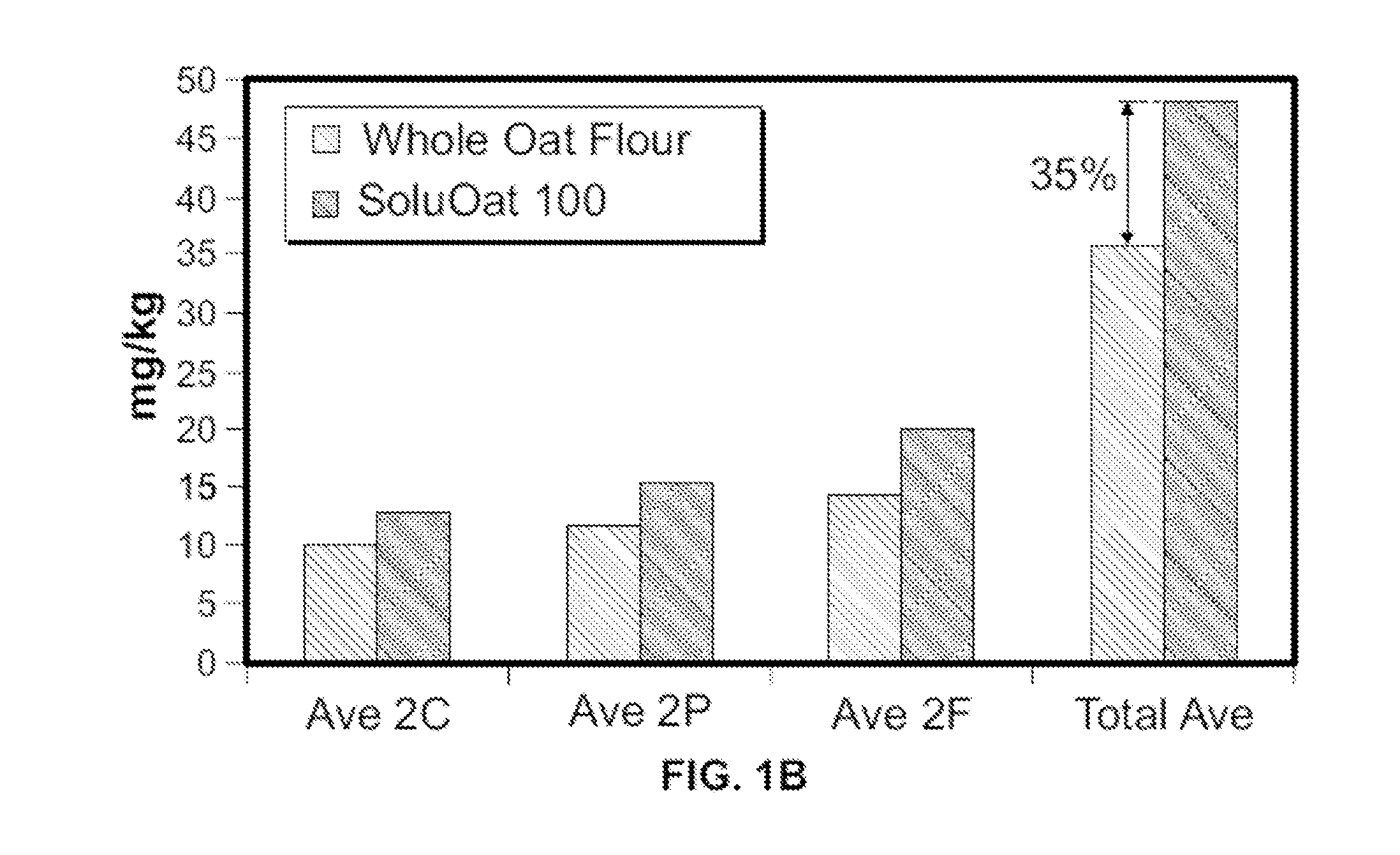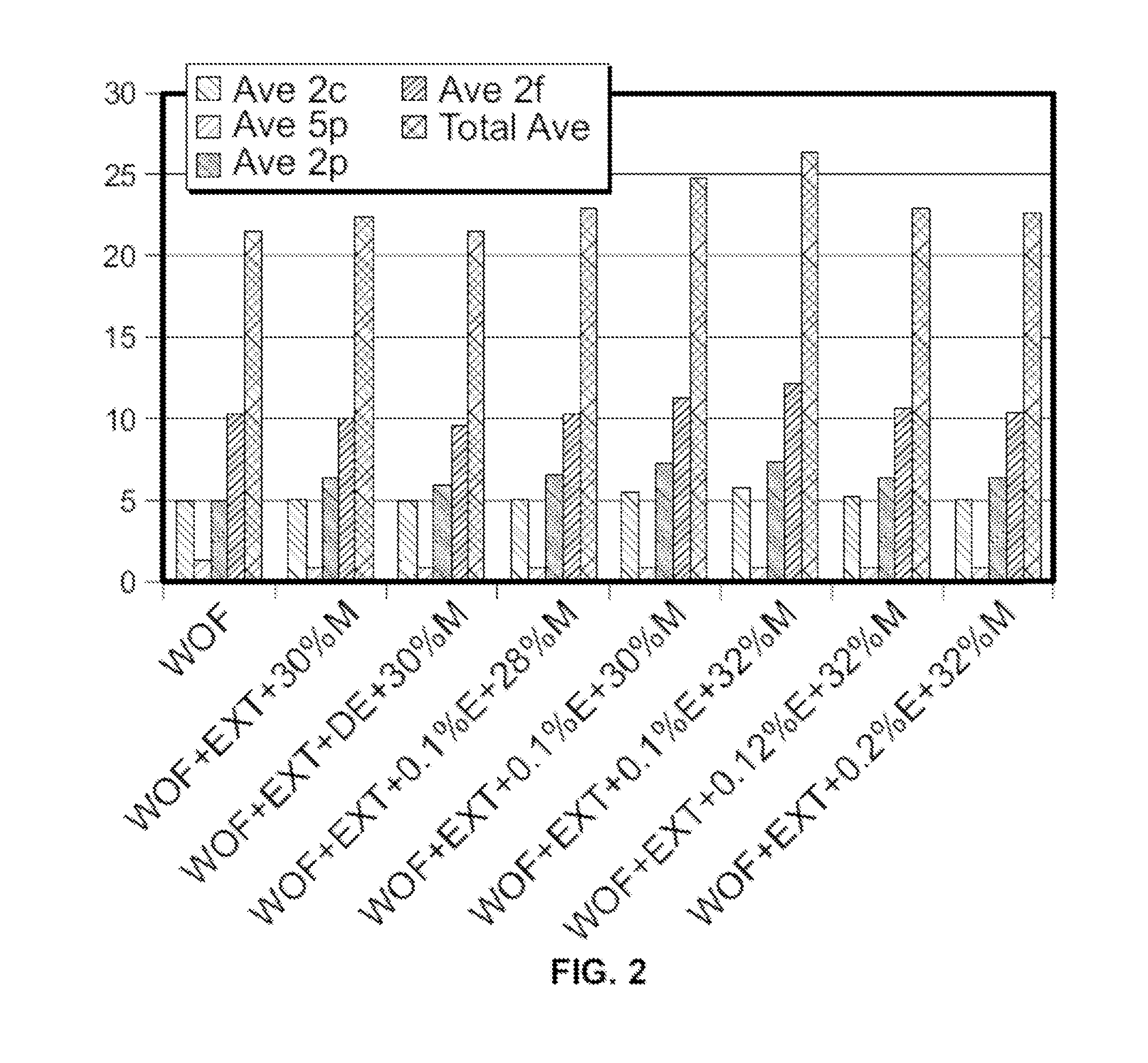Method of Processing Oats to Achieve Oats with an Increased Avenanthramide Content
a technology of avenanthramide and oat flour, which is applied in the field of whole oat flour, can solve the problems of low rate of soluble oat flour, and achieve the effect of improving health benefits
- Summary
- Abstract
- Description
- Claims
- Application Information
AI Technical Summary
Benefits of technology
Problems solved by technology
Method used
Image
Examples
example 1
[0059]The avenanthramide levels of the resulting soluble oat flour were measured using reverse-phase HPLC. Briefly dehulled grain was extracted, dried, and re-suspended into aliquots. Aliquots were analyzed by HPLC with a C-18 column using a diode array spectrophotometer detector with detection at 340 nm. The peaks were quantified by comparison to standard curves of authentic avenanthramides. The results of this testing are illustrated in FIG. 1A and FIG. 1B. The avenanthramide content of the soluble oat flour made in accordance with the methods described herein were also found to have higher avenanthramide content than oat flour processed using solely extrusion (no enzyme.)
[0060]In particular, FIG. 1A depicts the levels of avenanthramide 2c, avenanthramide 2p, avenanthramide 2f and the total avenanthramide (2c+2p+2f) in samples of native whole oat flour, extruded flour, and the SoluOat 100 flour made in accordance with the instant inventions. As used herein, “SoluOat 100,” or “Solu...
example 2
[0068]SoluOat flour and whole oat flour were produced in a traditional roller mill creating 150 micron of average particle size. The SoluOat flour was applied to various types of foods and beverages. The applications included instant flour application, dry ingredient in baking and yogurt processing, and ready-to-drink (RTD) beverage applications. A grainy texture was observed in some finished product applications containing the SoluOats. It was believed that the particle size of the SoluOat flour was the main driver for the grainy texture observed. As used herein “SoluOat,”“SoluOat flour,”“SoluOat 90” or “regular SoluOat,” whether singular or plural, shall mean 90% whole oat flour 5% sugar, 4.5% maltodextrin and 0.5% mixed tocopherol made in accordance with the methods set forth in the present disclosure.
[0069]Milled SoluOat flour was micronized using a Fluid Energy Micro-Jet Series 8 mill (jet mill) with a sock installed on the discharge to collect the milled (micronized) flour. A ...
example 3
[0081]Samples for RVA / viscosity testing were prepared by grinding samples to pass a 60 mesh sieve. A 3.44 gram sample at dry weight basis was measured and transferred to a sample pan. Deionized water was added to the sample for a total weight of 29 grams.
[0082]In accordance with the testing procedure, a sample of the soluble oat flour was stirred at 960 rpm for the first 10 seconds, and the stirring was reduced to 160 rpm during testing. The initial temperature of the sample was maintained at 50° C. for 1 minute and the temperature was increased to 95° C. for 3 minutes 45 seconds. The sample was held at 95° C. for 2 minute and 30 seconds and was cooled down to 50° C. for 3 minutes 45 seconds and test was complete after a 2 minute hold.
[0083]Peak viscosity of the samples is shown in the tables below. In particular, maximum viscosity was identified between 0 to 8 minutes and minimum viscosity between 5 to 10 minutes. Final viscosity was identified at the completion of the cooling stag...
PUM
 Login to View More
Login to View More Abstract
Description
Claims
Application Information
 Login to View More
Login to View More - R&D
- Intellectual Property
- Life Sciences
- Materials
- Tech Scout
- Unparalleled Data Quality
- Higher Quality Content
- 60% Fewer Hallucinations
Browse by: Latest US Patents, China's latest patents, Technical Efficacy Thesaurus, Application Domain, Technology Topic, Popular Technical Reports.
© 2025 PatSnap. All rights reserved.Legal|Privacy policy|Modern Slavery Act Transparency Statement|Sitemap|About US| Contact US: help@patsnap.com



